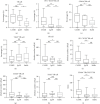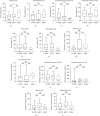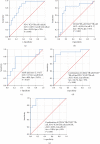The Ratio of CD226 and TIGIT Expression in Tfh and PD-1+ICOS+Tfh Cells Are Potential Biomarkers for Chronic Antibody-Mediated Rejection in Kidney Transplantation
- PMID: 35733922
- PMCID: PMC9206998
- DOI: 10.1155/2022/5326083
The Ratio of CD226 and TIGIT Expression in Tfh and PD-1+ICOS+Tfh Cells Are Potential Biomarkers for Chronic Antibody-Mediated Rejection in Kidney Transplantation
Abstract
Kidney transplantation is the ideal treatment for end-stage renal disease (ESRD). Chronic antibody-mediated rejection (CAMR) is the main cause of graft failure. Tfh and B cells are key immune cells that play important roles in CAMR. In this study, the populations of different Tfh cell phenotypes and B cell subsets in CAMR were investigated in a total of 36 patients. Based on Banff-2019, 15 patients were diagnosed with CAMR (CAMR group), 11 recipients were diagnosed with recurrent or de novo IgA nephropathy (IgAN group), and 10 patients displayed stable renal function (stable group). The Tfh and B cell subsets were analyzed by flow cytometry. The percentage and absolute number of PD-1+ICOS+Tfh cells were significantly higher in CAMR (p < 0.05), as was the ratio of CD226+Tfh cells to TIGIT+Tfh cells (p < 0.05). Compared with stable recipients, CAMR patients had lower naïve B cells and higher unswitched memory B cells, which were also significantly related to renal function (p < 0.05). Using the logistic regression model, we concluded that the estimated glomerular filtration rate (eGFR), absolute number of PD-1+ICOS+Tfh cells, and ratio of CD226+Tfh cells to TIGIT+Tfh cells were independent risk factors for CAMR. The combination of eGFR, PD-1+ICOS+Tfh cells, and the ratio of CD226+Tfh cells to TIGIT+Tfh cells showed better diagnostic efficacy for CAMR than each single parameter. The collective findings show that monitoring different Tfh phenotypes and B cell subsets is beneficial to kidney transplant recipients and implicate the combination of eGFR, number of PD-1+ICOS+Tfh cells, and ratio of CD226+Tfh cells to TIGIT+Tfh cells as a biomarker for diagnosing CAMR. The findings may also inform new strategies to identify and treat CAMR.
Copyright © 2022 Ji-wen Fan et al.
Conflict of interest statement
The authors declare no conflicts of interest regarding the publication of this paper.
Figures





References
MeSH terms
Substances
LinkOut - more resources
Full Text Sources
Medical
Research Materials
Miscellaneous

